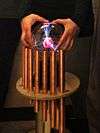Pyrophone
A pyrophone, also known as a "fire/explosion organ" or "fire/explosion calliope" is a musical instrument in which notes are sounded by explosions, or similar forms of rapid combustion, rapid heating, or the like. It was invented by Georges Frédéric Eugène Kastner.
Related musical instruments
The pyrophone is similar to the steam calliope, but the difference is that in the calliope the combustion is external to the resonant cavity, whereas the pyrophone is an internal combustion instrument. The difference initially seems insignificant, but external combustion is what gives the calliope its staccatto. Operating under the constant pressures of an external combustion chamber, the calliope merely directs exhaust. By controlling the combustion specific to each resonant chamber, the pyrophone has, for better or worse, a greater range of variables in play when producing tones. In a purely mechanical (non-solenoid) calliope, the resulting pressures of external combustion result in between one and five pounds of trigger pressure. In a mechanical pyrophone, trigger weight per key is related to comparatively lower backpressure of combustible gas. Again, the force of combustion happens in the resonance chamber; rather than controlling the exhaust of an explosion that has already happened in order to produce tones, the pyrophone controls the explosion to produce the tone.

Pyrophone history
Pyrophones originated in the 19th century.
Pyrophone fuel sources
Pyrophones are usually powered by propane, but gasoline powered mobile units have been built, to connect to automobile fuel intake manifolds and use the spark plugs and wiring, etc., to detonate one or more of the chambers. Hydrogen pyrophones are often made using upside-down glass test tubes as the combustion chambers.
References
- Les Flammes Chantantes, Georges Frédéric Eugène Kastner, Paris 1875.
External links
Audio
Video
Cinema
- http://www.offthegridproductions.com/NothingLikeDreaming/pages/film/index.html Movie "Nothing Like Dreaming" Directed by Nora Jacobson
